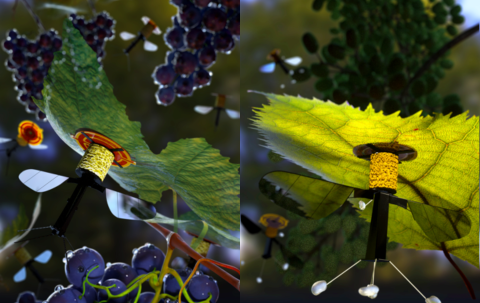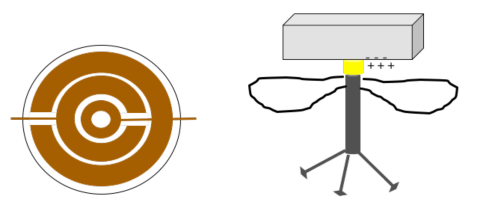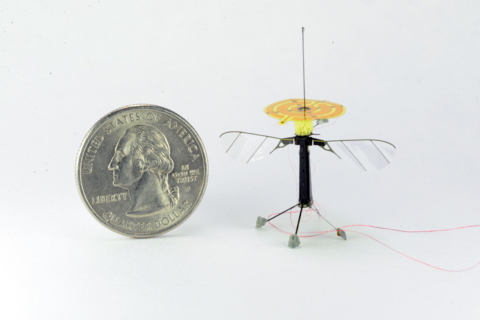Advances in Micro-Drones
June 21, 2016
Micro Air Vehicles, or MAVs as they are called, are small flying robots, usually modeled after insects and capable of getting to otherwise-inaccessible vantage points in a variety of situations. Due to their size, however, their mission times are limited by the energy supply they can carry. New research has found a promising way for these bug-bots to perch and take off from various surfaces in order to save energy and prolong mission times.1
Illustrations of MAVs deploying new electrostatic perching technology
Image Credit: Harvard's Paulson School of Engineering & Applied Sciences.
What Good are Flying Robots?
There are many conceivable uses for small, flying robots. The most significant would be to assist in areas or situations that are dangerous to humans. For example, they are perfect for viewing disaster areas, but they can do more than just provide visuals. Robots can carry detection systems to test for hazardous chemicals, radioactive isotopes, or biological agents, and transmit that information or store the data and bring it back with them. They can also be used to create a temporary, secure communication system with a relay antenna.
Bird-like vs. Bug-like Bots
Flying robots have been around for a while, and most mimic birds or insects—these are biological blueprints that have been perfected for efficiency and aerodynamicity over billions of years of natural selection, so it makes sense to start there rather than “from scratch”. DARPA has developed fantastic humming bird robots, shown in the video below2
But flying takes a lot of energy, so a micro-drone is restricted by the weight of the energy supply it can carry with it, and its mechanical components.1 Missions can be prolonged if energy is saved by having the robot perch at a vantage point for a while. Micro Air Vehicles or MAVs are predominantly modeled after flying insects. Insect robots are less expensive to produce, more intricate, and have the possibility of greater agility, but they also have more instability with maneuvering than bird sized robots, and they are more difficult to perch.1
Putting together the small parts of insect bots could also be very difficult, but a team at Harvard found an amazing way—inspired by pop-up books and origami—to assemble these miniature devices a few years back. The video below discusses how this is done and how these bots can be produced in mass quantities.3
So why insect bots, rather than bird bots? They can be quickly and inexpensively mass-produced with the pop-up method, and the same lightness that makes insect bots unstable in-flight is also what gives them their characteristic agility. The primary questions of development are now just matters of controlling the bot’s flight and prolonging mission time by figuring out a way to perch and take off.
Challenges: Perching & Take-off
Researchers have tried many different approaches to perching, from gripping mechanisms, directional adhesives, lever systems, chemical adhesives, magnets, needles, and microspines, but these tests have been done with the larger bird-sized bots.1 Many of these methods have issues with irreversibility or applicability with insect bots.
The researchers behind this paper realized that, since the insect bot is so light, using electrostatics to adhere the insect bot to a perch is a perfect fit. This method would not be feasible for the larger bird-sized robots. The electrostatic adhesion is based on the attraction of like charges and repulsion of opposite charges. The principle behind the method is similar to how a balloon adheres to a surface after you rub it against your hair. Rubbing the balloon against your hair adds electrons (negative charge) to the balloon from your hair that stay put on the balloon because of the insulating material it is made of. When you bring the balloon near a surface, it pushes the electrons near the surface away (polarizes it) because like charges repel and electrons can be moved somewhat easily, whereas the positive protons in the nucleus of an atom in a solid don’t move significantly through the solid. The negatively charged balloon then feels an attraction to the surface that is more positively charged (opposite charges attract). Linked below is a PhET simulator you can test out and “see” this electrostatic property in action4. Notice that the “pull” between two objects depends on both the amount of charge AND the distance between charges.
To get a feel for this yourself, you can experiment with electrostatics using this flash simulator from UC Boulder's PhET project!
For the insect bot, a circular electrode patch with interlaced electrodes was used. It looks similar to the diagram shown below. The copper color in the diagram represents conducting copper wire. By maintaining a constant voltage across the two terminals, charges are built up on the electrodes. There are regions of both positive and negative charges. When the electrode, covered with a thin film, is brought near a surface, the positive charges attract negative electrons in the surface and pull them toward it. The negative charges push the electrons in the surface back, resulting in an opposing oppositely charged surface that the electrode is attracted to.

A diagram of an interdigitated circular copper electrode which is used to create a static charge, allowing it to cling to just about any surface.
To “unstick” the robot, all that is necessary is to turn off the voltage across the circular electrodes, allowing the charge to redistribute.
This works surprisingly well for adhering the insect bot to just about any surface. The researchers tried plywood, leaves, glass, and metal of various roughness. However there are some issues that affect how well this works. One issue is humidity. A balloon electrostatically held to a wall can not stay there too long on a humid day, because water molecules in the air can easily attract and carry away an electron charge. This occurs with the insect bot as well, and ends up decreasing the energy supply at a faster rate. Another issue is roughness of the surface the robot is trying to adhere to—if the surface is very rough, then the distance between the charged electrode and the low points of the rough surface can significantly reduce the electrostatic pull.
By far, the biggest difficulty that arises with perching is how the bot is affected when it nears a perching surface. Imagine an upward moving elevator nearing the desired floor. It should slow down and stop, but what if the upward force suddenly increased? An increase in the upward force would make the elevator go faster in the upward direction rather than slower. This is what the researchers found to happen with their insect bot. The researchers note more than a 40% increase in the lift force as the insect bot approaches a perching surface!1 They studied bees landing to a perched position and noted that bees seem to come in with a speed that decreases linearly with the distance to the perching surface.
To handle the increase in force and avoid crashing into a perching surface, the researchers mounted a light, springy, tube-shaped, polyurethane foam “bumper” on the robot, and then mounted the electrode to the foam.

A photograph of the robot showing the yellow "bumper" under the electrode.
Image Credit: M.A. Graule, K.Y. Ma, Wyss Institute for Biologically Inspired Engineering
They also realized by studying bees, that the insect bot should hover under the surface, stabilizing its flight, before trying to perch and just after take off. The video that the researchers included in their report shows footage of the insect bot perching and taking off of various materials.1 The materials in the video include plywood, glass, and a leaf. The video is shown in real time and then at one-eighth the speed. The quarter is there just to give an idea of the size.
The researchers report the perching bee bot uses three orders of magnitude (i.e. divide by 1000) less energy than it does in flight!l
Future Research & Applications
The researchers note that there are many challenges for insect-like robots due to their size, which also means a reduced size of detectors, power supply, and the difficulty of controlled flight, but they note that there are many advantages to overcoming these difficulties.1; The researchers also point out that electrostatic adhesion may be useful for crawling insect robots to climb on vertical or inverted surfaces.
References and Resources
1. Graule, M.A., et al. Perching and takeoff of a robotic insect on overhangs using switchable electrostatic adhesion. Science 352, 978-982 20 May 2016
2. DARPA Nano Air Vehicle (NAV) program, Hummingbird Drone
3. Pop-up fabrication of the Harvard Monolithic Bee (Mobee)
4. PhET Simulator. University of Colorado at Boulder.
—H.M. Doss














